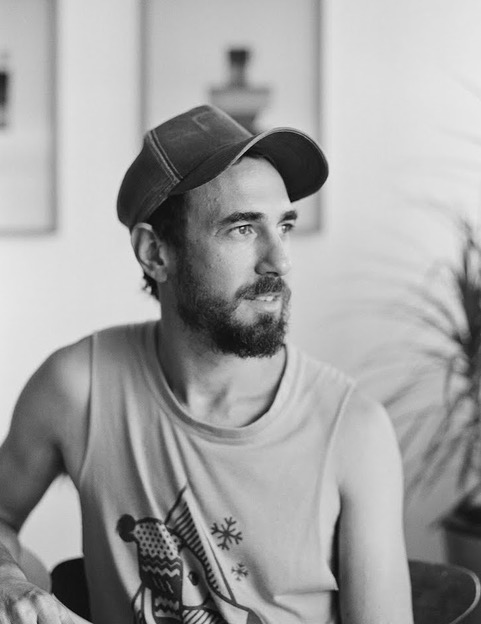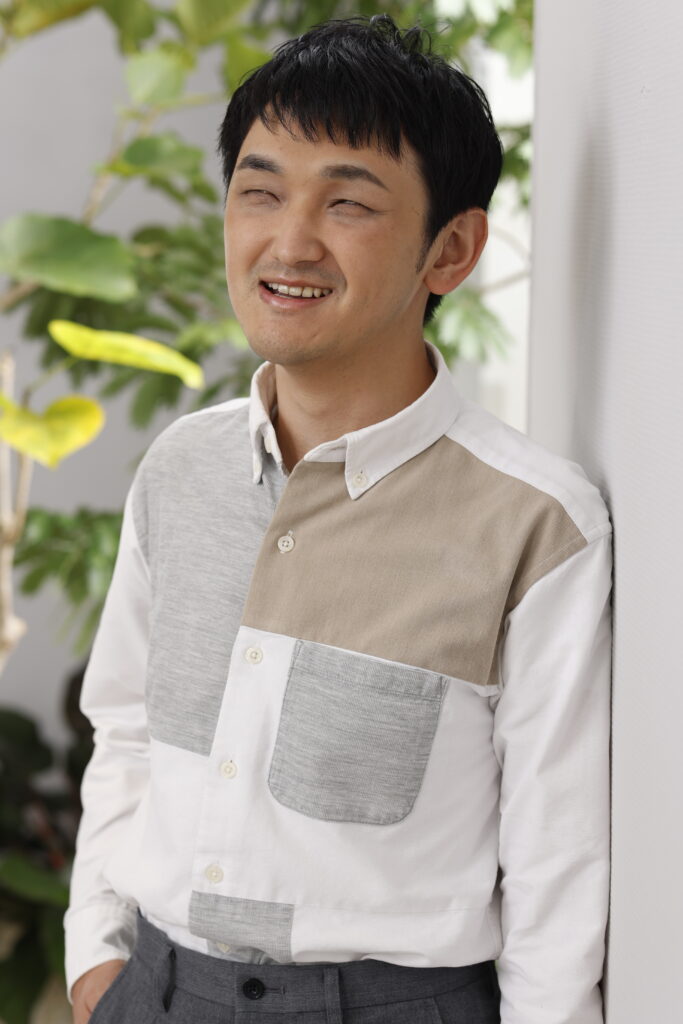Blind Drive is a sound-based game that uses stereophonic sound and adds visual aids. During his visit, Giori Politi, the game’s designer and pioneer of audio games, joined curator Miyuki Tanaka and programmer Nozawa Yukio in a discussion of how Blind Drive came into being, its unexpected entry in the Google Play Indie Games Contest, and subsequent impact in the game industry.
The Beginnings of Blind Drive
Tanaka Miyuki: Thank you for taking the time to speak with us. I’d like or dive right in: you were saying that you didn’t know about audio games until you created Blind Drive but how did your approach to have sound at the heart of the game start?
Giori Politi: Well, that’s because I’m originally a sound designer and I wondered what it would be like to experience an everyday action, like driving, with sound alone. The original idea was to make an interactive installation inside a real car dashboard.
I made a very small version before that in Max/MSP. It was primarily a demo of driving a car. I showed it to my friend, D.A. Terre, and we both thought, “that’s a cool idea.” First, we tried to make an installation out of it; we were already working on some projects together with Lo-Fi People and thought that it would be a good idea for an installation where you sit in a car dashboard and hear all these sounds but don’t see anything. So, we started to sketch it and then we felt, “wow, this is really cool. It could be a video game.”
From there, we started researching: first, I wanted to know if these kinds of games even existed. I would play games but I’m not a gamer, and didn’t know there was even a genre called audio games.
Then, I saw that there are many games online, on the Audio Games Network or AudioGames.net. I don’t remember their names, but I saw a few on there, like the French game A Blind Legend.
Tanaka: Games that only have audio?
Politi: Yes, there were a few. I also played Papa Sangre. I was also exposed to the whole binaural sound too, like The Binaural Barber on YouTube.
Nozawa Yukio: That video is extremely popular.
Politi: Yes, it’s amazing with such a simple technique. So, we decided to go in that direction: to make a game based on audio with a binaural sound to add an immersive feeling to it, because most games that I saw were not as immersive. They were just “audio based.”
Tanaka: What do you mean by “immersive”?
Politi: Something that makes you feel and become aware of your senses; something that give you a stronger, more powerful experience. This became a 20-minute demo that we later sent to the Google Play Indie Games Contest.
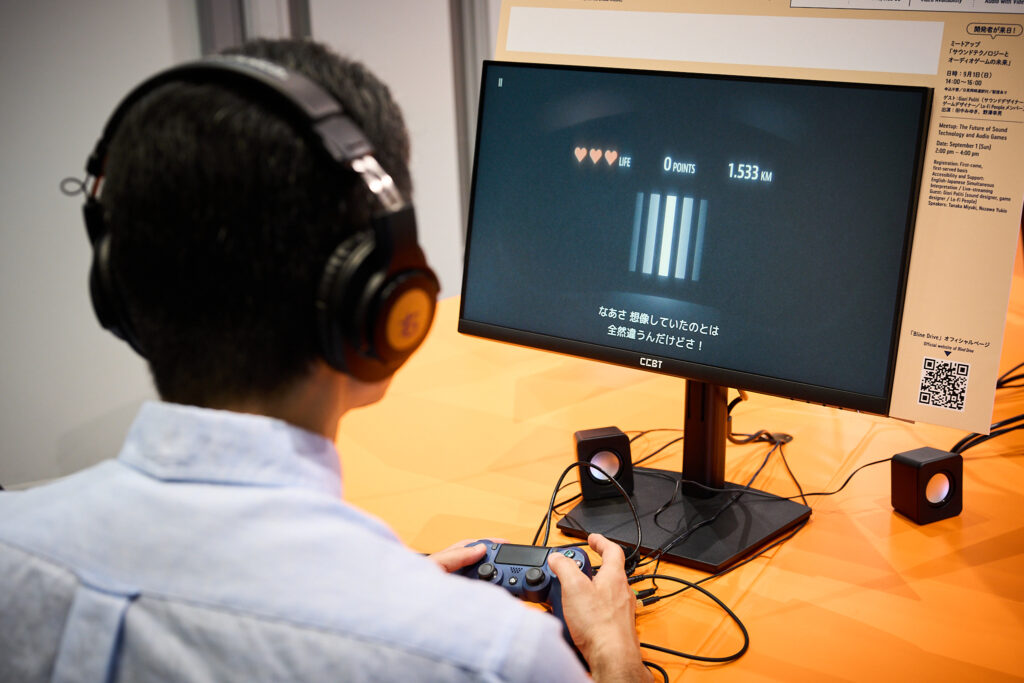
Entry into the Google Play Indie Games Contest
Tanaka: Would it be up still?
Politi: It was 2017, so it’s already been several years, but it might be. In that version, D.A. was doing all of the voices, and we wrote the script together. It was a bit different, but some of the elements are still in the game.
Tanaka: What are the same, for example?
Politi: The settings, for one. We also had the Kidnapper and Donnie’s character too, although we didn’t call him Donnie then. We also had Grandma, but she wasn’t a big part of the game. She appeared only towards the end.
Initially, we were only working on it one evening a week or even two weeks. Then, for the Google Play Indie Games Contest, we sat down and really worked on it. We then sent it to the Contest, the game got selected, and we were invited to attend.
The “Accidental” Black Screen
Politi: The Contest was in London and there were twenty other games that were selected. Most of them are quite famous games; some were successful ones made by larger studios.
Tanaka: Were you awarded money for the Contest?
Politi: No. We won an award, but I don’t think they even paid for our flights or accommodation.
Tanaka: So, you were just selected for the Contest?
Politi: Right, we were selected and invited to attend. But I think this is the norm, to be honest: game contests rarely pay nominees to come. Nevertheless, we were flattered and thought it would be a wonderful opportunity. We attended and was selected as the Top Ten.
I have a funny story about this: when we got to the Contest, there was an exhibit of all of the twenty games that were first nominated, and we saw our game on a Google device, but the screen was pitch black. The thing is: our game had some visual graphics. But when we saw it at the exhibit, there was no graphics at all.
Tanaka: What do you mean?
Politi: It was just a black screen. We had arrived earlier in the day for the set-up, so we asked the judges about it, and they simply said, “Yeah, this is the game.” There was a little back and forth, and when we checked it again, the screen was still completely black. But players somehow managed to press “start game.”
Tanaka: How?
Politi: It somehow worked. So, when the players were on it, it was only audio and a black screen.
Tanaka: So, it was an accident?
Politi: It was a bug. During the set-up, D.A. debugged it, but it was a bug on the Google device. We fixed it for the exhibit, but it’s just funny how they chose the game that had no graphics.
So going back, we got selected as one of the ten finalists and they featured our games on the Google Play Store.
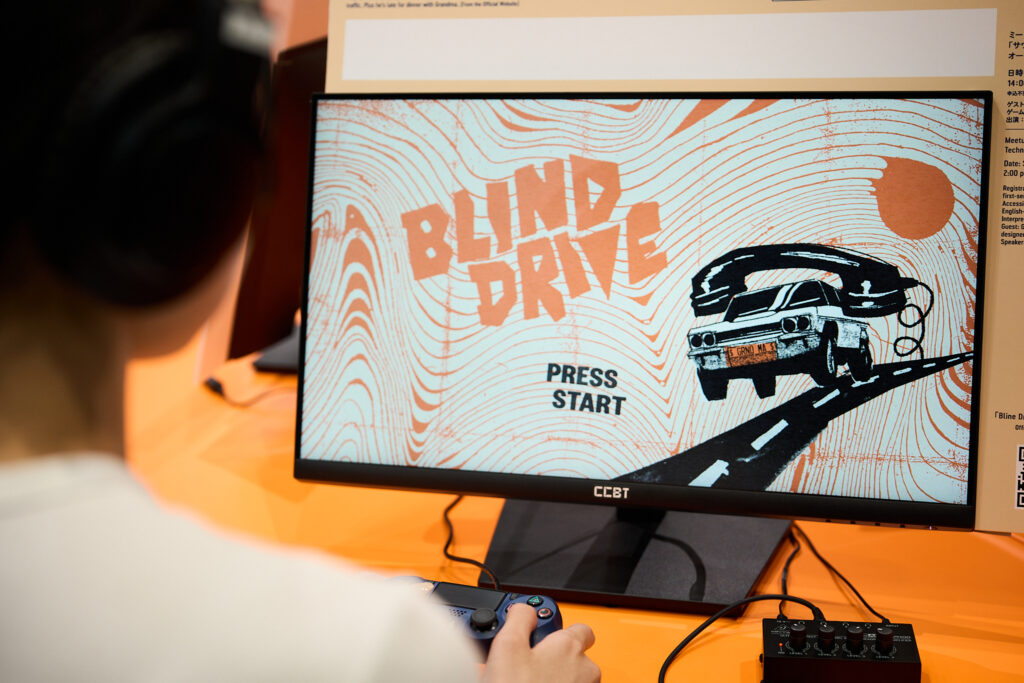
Blind Drive: The Beta-version and its Final Release
Politi: As I said, the game was almost completely accessible: people played on it without any visuals at the Google Play Indie Games Contest. So, it was already almost there. Then, we were starting to work with many beta testers, and during the COVID-19 pandemic, we had time to work on it and finally released Blind Drive in 2021.
Another funny thing is that the beta version is still online, and people still play it. Here it is [showing beta version of Blind Drive]. This is how the game looked like before. It was about 15, 20 minutes.
Tanaka: There’re a lot of videos on YouTube that people play on it blindfolded.
Politi: Exactly, that was also funny.
Tanaka: Do you mind if I asked you how much the budget was for making it?
Politi: Well, it was our own, independent project, so no one paid us, if that is what you mean. We paid for the graphic designer and the voice actors, but it didn’t cost us a huge amount because it was only for a few sessions. It cost us, maybe, a few thousand dollars, 10 or 20, all in all. But it mostly cost us time: we really spent a lot of hours on this game because this was our first game of this scale.
I had worked on different games before, but only as a sound designer. My partner and I didn’t quite know what producing a game yourself would entail, and it was a lot of work.
Tanaka: How long did it take for the whole production?
Politi: Well, I think we started the first Max/MSP version in, maybe, 2013 or 2015. Then, we started the one for Google from 2017 and I really gave it all my time in the last year, I think. I worked 100% on the game for one year.
Tanaka: 2021, was it?
Politi: It was released in March 2021. The COVID-19 pandemic began in Israel in January 2020 and, a month or two in, we realized that lockdown was going to be for a while. So, I had the time to do it. It was kind of by chance.
Tanaka: It’s good to know that we were sharing the similar situation across the globe.
Politi: There was one publisher that got back to us—a medium-sized, Indie publisher—so we began to talk with them about promoting the game, but in the end, we decided to produce it ourselves. I think it was actually a good decision because it made us more invested in the game. It was a personal project, so we went all in. We wanted to do it our way: to produce the videos the way we think it should be done.
Freelance and In-house Sound Designers and Audio Games Creators
Tanaka: I think it’s important to note again that you’re not originally from the game industry, but you happened to create an audio game by chance.
Politi: Back then, I was more from the field of making installation and interactive art, and that was the idea for Blind Drive. I had some interaction with the field and, as it turned out, a lot of members from Lo-Fi People were also making installations. Some were making installations that are more personal and artistic, and others that were more, say, commercialized for clients. Also, they weren’t really games, but we were also creating interactive toys and iPhone apps that were more playful, not too artistic or abstract and not too commercialized but somewhere in the middle. That all came quite natural for us.
Tanaka: It’s actually quite difficult to have a sound designer on the team when creating audio games because most of them belong to game companies that have strict rules and regulations.
Politi: Are there any sound designers who work freelance in Japan?
Nozawa: There are, but their skills vary quite a bit.
Tanaka: And audio games usually don’t make a lot of money. So, it’s difficult to have someone skilled and talented.
Politi: Most of the work I do is independent. In Israel, there are a few studios that have in-house sound designers, but most make smaller games that don’t require in-house sound designers. So, you [freelance sound designers] come and work on a game for a few months and then continue onto the next one.
New Techniques for Blind Drive
Tanaka: Going back to the sound design of the game, I wanted to ask: are all the techniques or technologies used in Blind Drive something that you previously acquired as a sound designer? Or are there new techniques that you explored for Blind Drive?
Politi: I already knew about interactive sound design and spatialized sound from working on installations and other pieces: I was already using multi-speaker systems and three-dimensional sounds. But I learned so much about binaural techniques and understanding that you can custom-create the HRTF to your ears.
That’s when I realized that HRTF sounds differently to us. I read so many articles about spatial sounds and HRTF, about perception and spatializers. I checked so many different tools, so I did learn many things while working on this game. It was fun.
Tanaka: Someone asked about how you incorporated 3D mix in the game.
Politi: Right. As I said, there were three different kinds of techniques. First, for the enemy’s cars, we took a mono file of the car, and with dearVR Pro, I moved it to create this movement [recreating movement] and then processed and exported it into a stereo file which I played back. If it’s from the other side, I just switched the channels. That was one technique I used.
The second one was, we recorded binaural files and played them back as they are like stereo files that already have all the spatialized information in them. There were ones where I used IR files that process different movements in different places in the car. But in the end, we also used baked sound files too.
Third, there are a few sounds like the Police, the Enemy, and the Chopper that move in 3D and, for those, we used the built-in FMOD Spatializer: we used this for everything that needed to be moved in real-time. We created movements within Unity that move them such as the Police and the shooting guns.

Meetup: The Future of Sound Technology and Audio Games
The Impact of Blind Drive in the Game Industry
Tanaka: Could you also tell us about how you think Blind Drive may have impacted the game industry or other games?
Politi: In the game industry, I think it’s good how people were exposed to this kind of game; they may have experienced a different possibility especially in terms of using sound in a creative way in video games. I think we were able to add sound-based games into an industry full of games that are not based on sound.
I think the game somehow worked favorably in terms of accessibility too. It was really pleasing to see that they used this game as one of the good references: Ian Hamilton (@ianhamilton_), who is an accessibility specialist for games, tagged me on X (formerly Twitter) where he was taking a frame from a keynote [about accessibility in games] and Blind Drive was used as an example.
Tanaka: Do you think what you explored or implemented in Blind Drive hadn’t really been explored yet in mainstream video games?
Politi: I think most of the things that we did have already existed. But I do think we made something that is of a very high-level and we really broadened the possibility of the medium itself.
Also, there are a few gameplays that we developed which are a bit more complex. For instance, the bosses or the Police. This gameplay was actually really difficult to get working in the sense of action, what you need to hear and to listen to, what you have to do, and the timing of it all to get the mechanism of this battle. It took us some time to really get to that point. The mechanism of the Chopper that shoots at you and then reloads, too, resembles the traditional boss: the final boss that keeps shootings at you but, after a while, you figure out a pattern in their movement and find a window to counterattack.
That is a really old formula, like in the Mario games. But it took quite a bit of time for me to understand that to transform that into sound wasn’t so straightforward.
Tanaka: Did you talk with blind gamers, or you experimented with them?
Politi: We experimented it ourselves, D.A. and I. The two bosses—the Police and the Chopper—really helped us to understand the sequence of their actions and each of their timing. Every time before the Police comes and attacks you, he says a sentence which helps the player to understand, “Okay, that’s my cue.”
Nozawa: I thought that too.
Politi: Right. Also, at the beginning, the police siren was not very loud, so it was a bit difficult to differentiate it from the other sounds. So now, we made the police siren very distinct. There was a lot of trial-and-error to get to this final product.
The Technical and Narratives in Audio Games
Tanaka: What was the process of making the story?
Politi: D.A. made the storyline and wrote the script. We would think about ideas together, but he wrote the exact lines. D.A. is really into narrative games, and we wanted to have an interesting narrative; not just a game that is technical. We wanted the game to provide the full experience.
Tanaka: We always try to find a balance between experimenting with sound and the storyline, but it can be difficult.
Politi: Right, it’s interesting. We discussed thoroughly about how to present the game because we didn’t want to call it an “audio game” per se. On the PR pages, I think it says, “a game that you can play with your eyes closed,” or a game “based on sound,” or “play with your ears.” We didn’t want to categorize it as a game for one particular demographic because that wasn’t our original intention. I think that even the title of one of the articles that came after the Google Contest was “VR for Your Ears.”
We thought about how players [of all types] could get the most out of the game. It’s an interactive game.
We felt there’s something about sound-based games that are so strong. If you close your eyes, you can imagine the situation, and it can have much more impact; it can be quite immersive.
Tanaka: I agree.
Politi: There was one review that said that hitting the people felt so realistic for him. So, although he enjoyed the game before, he said that it was too intense and didn’t enjoy it as much. I think he said he played it right after an automobile incident in London—someone ran over a few people—and he said the game reminded him of that. We had a few more reviews like that.
That particular level is also a semi-boss level, so you hit ten or twenty people to leave the city and into the next level. But the thing is, the game doesn’t say that you have to hit the people; we only wanted to give the option to do so for some people.
Dark Humor in Audio Games
Politi: Of course, it was important for a game to have a storyline and for players to have an emotional journey. But we also wanted Blind Drive to become really wacky with an unreal script and funny because many audio games tend to be dark in nature. You are playing a game without seeing, which is already kind of scary. So, we didn’t want to go for the clichés but, instead, designed the game to be crazier, to give players a funny experience, and for them to not take the game too seriously.
I think in the first couple of levels players may still think, “okay, this could be dark and heavy.” But the moment Grandma calls, it all starts to be funnier. And then the ice cream truck and so on. It’s not real or realistic. You can’t take it seriously.
Nozawa: I had one question. Who are the weird, screaming people that approached us at the final boss stage?
Politi: They are actually a reference to the cannibalistic characters in Mad Max. They’re not really cannibals, but I imagined these strange, steampunk dudes on bicycles.
Nozawa: It’s very interesting. I now know that you designed and created Blind Drive with a lot of attention to the details and spent a lot of time on it.
Politi: I admit I’m very proud of this game. I have a few in my life that I feel are my projects and it feels like such an accomplishment to have one that gets noticed. That makes me feel like it was worth all the work. To see people playing it and reacting to it is so much fun. So, thank you very much for inviting me.
Nozawa: It was our pleasure.
Tanaka: Thank you for coming.
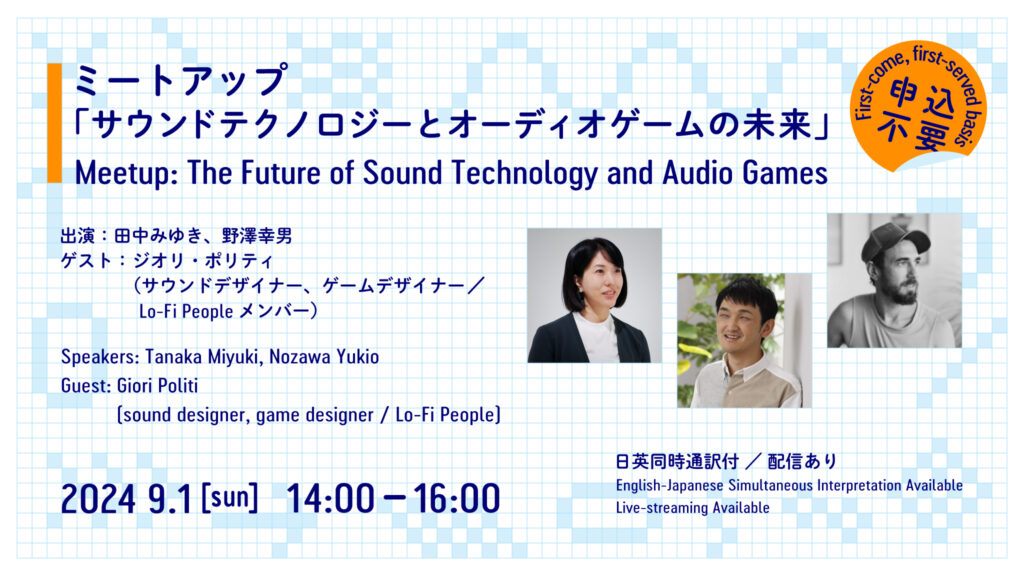
Meetup: The Future of Sound Technology and Audio Games
Date: September 1 (Sun), 2024
Time: 2:00 pm – 4:00 pm
Venue: Civic Creative Base Tokyo
Speakers: Tanaka Miyuki, Nozawa Yukio
Guest: Giori Politi (sound designer, game designer / Lo-Fi People)

